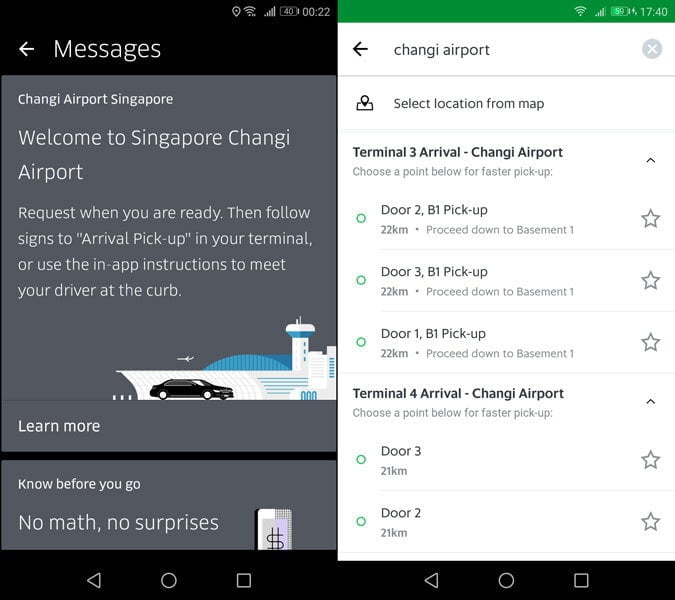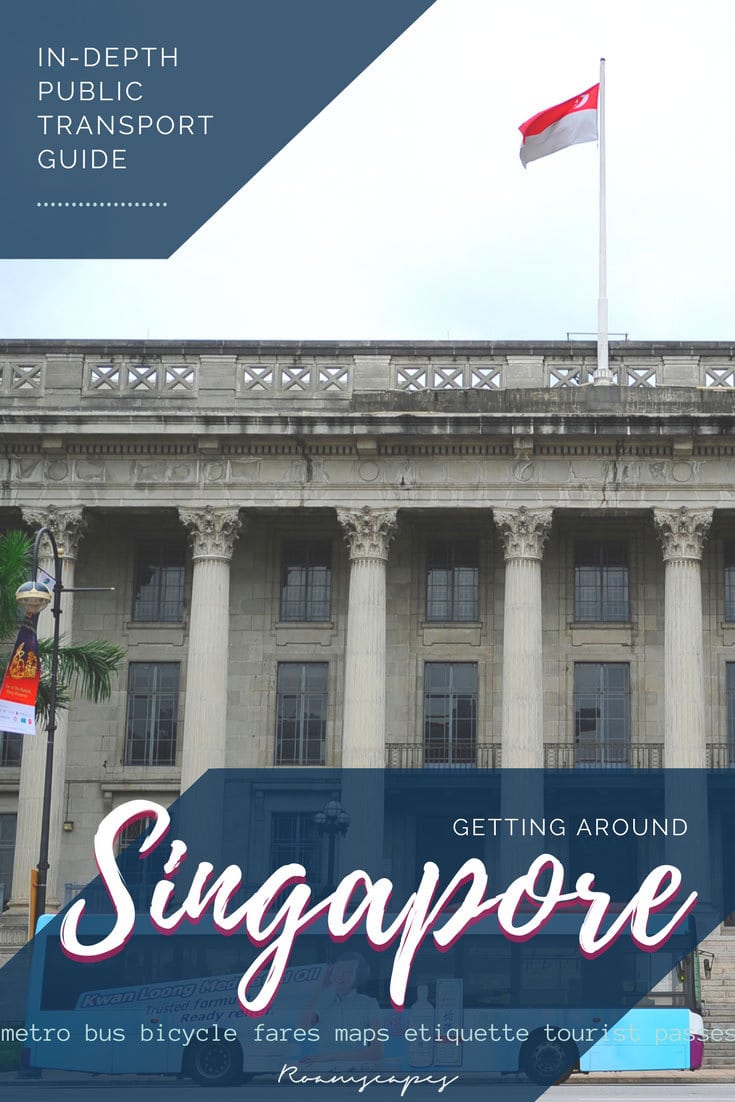Small and densely-packed Singapore boasts a highly acclaimed (and affordable) public transport system that will let you find even secret local attractions with ease. This super-thorough guide will share everything you need to know for getting around Singapore by bus, metro, and taxi.
If you have a question that’s not answered here, drop a comment or catch me on Instagram/Facebook so I can help you out and improve this guide.
Before you arrive: what to prepare
Since Singapore has four official languages, all public signage is written in English with Malay, Chinese, and Tamil for important signs. You won’t have any problems finding your way around.

Google Maps with public transit information is readily available, as are apps like Citymapper and Moovit. I definitely recommend Citymapper as an all-in-one app with the most thorough step-by-step navigation! This is rather important if you like to go off the beaten path – Singapore’s streets aren’t laid out in neat grids like many European and US cities.
On arrival: the EZ-Link/FlashPay card
Flying in to Singapore, you’ll arrive at the esteemed Singapore Changi Airport (SIN). Upon arrival, you can purchase either the EZ-Link or NETS FlashPay card for use as your transport fare card. However, you don’t need a fare card at all – you can pay for MRT (metro) and bus rides using your credit/debit card or with Google Pay/Apple Pay on your phone! The only downside is that your bank may charge FX (currency conversion) fees for overseas transactions or block your card if it suspects that your card’s been stolen.
That said, what’s the difference between EZ-Link and FlashPay? For a visitor, both cards are virtually the same. They’re both contactless, reloadable fare cards used for public transport in Singapore. Both can also be used for contactless payments at some convenience stores and food outlets, but I recommend using your credit card instead – especially if you can rack up frequent flyer miles/points!

Where can I buy my EZ-Link/FlashPay card? Once you’re ready to hit the city, follow the signs in the airport that say MRT – that stands for Mass Rapid Transit, our subway/metro system. You can buy an EZ-Link/FlashPay card at the Ticket Office (open 0800-2100).
*The ticketing machines only sell single-journey tickets, not the reloadable fare cards.
**You can also get your card at any 7-Eleven convenience stores islandwide.
Where can I reload my EZ-Link/FlashPay card? You can top-up your card at any of the ticketing machines in each MRT station. These accept cash, credit card, or Apple/Android/Samsung Pay. You can also reload your card at all 7-Eleven or Cheers convenience stores islandwide.
Can EZ-Link/FlashPay cards be shared? No. Each card can only be tapped once, so each traveler has to have their own card. However, children below 7 years old and not taller than 90cm travel free on buses and MRT trains!
Does the EZ-Link/FlashPay card expire? Unfortunately, yes. The cards expire after 5 and 7 years respectively, so if you don’t plan on visiting Singapore again, you can get a refund on your card’s stored value. Simply head to the Ticket Office at any MRT station to return your fare card and get your money back.
Getting from Changi Airport to Downtown Singapore
If you’ve already gotten your EZ-Link/FlashPay card at the Changi Airport MRT station, you’re ready to take the MRT to town (or anywhere in Singapore, really.) Here’s what you need to know to start using the Singapore MRT.
- Changi Airport station is on a split off the East-West line, and the train terminates just two stops later at Tanah Merah station. To head downtown, you’ll need to switch to a train towards Joo Koon station (heading west).
- Tap in/out at the automated gantries to enter and exit any station. You can’t dodge fares here!
- The fare structure is distance-based, starting from less than S$1 and maxing out at just S$2.02. Who says Singapore is expensive? 😛
Alternatives to the MRT
For arrivals at odd hours, the 24-hour City Shuttle will take passengers to most downtown hotels at S$9 per adult / S$6 per child (below 12 years of age). You’ll have to wait between 15-30 minutes for each shuttle, though. Learn more here.
You can also get a taxi from the taxi rank, or use a ride-hailing service like Grab or Gojek (the apps will direct you to different pick-up points depending on the terminal.) If your location isn’t auto-detected, enter “Changi Airport” and you’ll automatically see options for your terminal and pick-up door. A ride downtown should cost around S$25.

Getting around Singapore: taking the MRT
Singapore’s metro, the MRT, consists of five lines (with more on the way). The city center/downtown area is concentrated in the southern part of the island and most visitors will stay in this area.
MRT stations are highly accessible, with elevators in each station, wheelchair-friendly gantries and ramps, and tactile paving for the visually impaired. Maps and signs everywhere are in English. However…
- For such a vibrant city, the Singapore MRT operates only from 5.30am until midnight on most days. If you’re going to check out the nightlife, look for a night bus service or use Uber/Grab/taxi.
- Most MRT stations have a central platform and trains stopping on either side, so you won’t end up on the wrong direction platform. A few stations, like City Hall interchange, do require you to go down specific escalators for specific travel directions.
- There’s also a Light Rail Transit (LRT) system in certain residential estates, though you’re unlikely to use them.
Getting around Singapore: taking public buses
Singapore has plenty of public buses, which I personally prefer over the MRT since it means less walking out in the blistering heat/torrential rain.
When taking a public bus in Singapore, you must board at the front door and tap your transit card on the reader. When alighting, alight at the back door whenever possible (you can alight from the front if the bus is packed) and tap out – if you forget this, the maximum fare (typically S$2.02) is deducted from your card!
- Most public buses do not have displays showing the next stop. Buses also do not stop at every stop – you must press the bell to alight. Ask the driver for help if you’re unsure!
- If you use Citymapper, it’ll show your route on a map, bus arrival times, as well as the number of stops you’ll need to pass!
If you’re traveling around Singapore on a budget, buses are more convenient for attractions not accessible by MRT (like these cool coffee spots.)
Since the MRT shuts down around midnight daily, the night buses are the best option for getting back to your accommodation after exploring Singapore at night. Check the Nite Owl and Night Rider services for routes. On the downside, they only operate on Fridays, Saturdays, and eve of public holidays. Because no one gets to stay out late when the next day is a workday.
Singapore public transport etiquette & safety
When getting around Singapore in trains and buses, take note of the following:
- In a holdover from our days as a British colony, traffic goes on the left side of roads and pavements; when using escalators, stand on the left and walk/overtake on the right.
- Most Singaporeans value their personal space and even in a crowded train or bus, commuters maintain some distance. Physical contact is not appreciated.
- Although most of us will form orderly queues to board trains and buses, there will be instances where people barge in!
- There are no women-only cars, but Singapore is by and large a very safe city.
- In fact, it’s so safe that most people don’t keep an eye on their back pocket, open handbags or other belongings. Do stay alert. As the police like to say, low crime doesn’t mean no crime.
Should you get the Singapore Tourist Pass?
The Singapore Tourist Pass is the official transit pass for tourists, and it comes in two variations: standard pass and Singapore Tourist Pass Plus. Here’s a quick comparison of the two:

Singapore Tourist Pass
S$10/16/20 (1-3 days); S$10 deposit
- Unlimited rides on standard public buses and the MRT
A pretty good deal since a single trip costs S$1.20 on average, but you have to return the card for your deposit.

Singapore Tourist Pass Plus
S$28/38 (1 or 3 days)
- Unlimited rides on standard public buses and the MRT
- Choose 4 out of 9 perks: admission to Chinatown Heritage Centre, Mint Museum of Toys, and a range of Singaporean dishes at a local diner
The Plus perks aren’t really worth it; you can try great Singaporean food nearly everywhere at cheaper prices!
Plan your trip
Singapore is hot (~32°C) and humid all year round, with plenty of rain, especially in the monsoon season (November-January).
Traveling out of Singapore
Yes, you can travel out of Singapore by public transport! Public buses 160, 170, 170x and 950 will take you across the Causeway to Johor Bahru in Malaysia (it’s a nice little day trip). There are several bus services by Causeway Link, a Malaysian transit provider.
As you’re technically traveling from one country to another, please make sure you have your passport and the required visa to enter Malaysia. Wherever you board the bus, you’ll have to disembark and clear two Customs checkpoints: on the Singaporean side of the Causeway, and on the Malaysian side. For more details on going from Singapore to Johor Bahru by bus, peruse this thorough guide by fellow blogger Eva of Trevallog.
Tip: While this isn’t public transport, you can also travel to Malaysia by rail and Batam or Bintan in Indonesia by ferry.
PLAN YOUR TRIP
Find more Singapore travel inspiration with our guides. Better yet, start planning your trip!





Leave a Reply